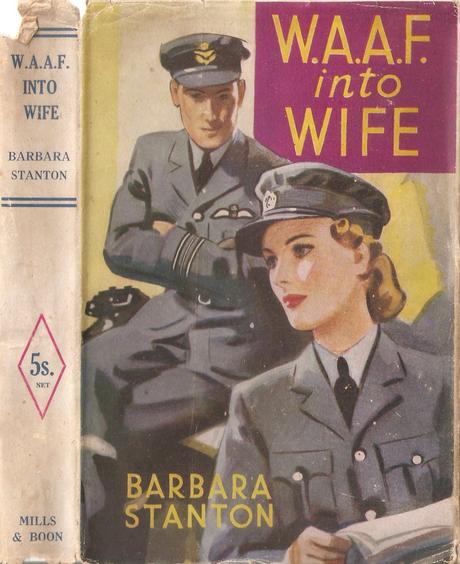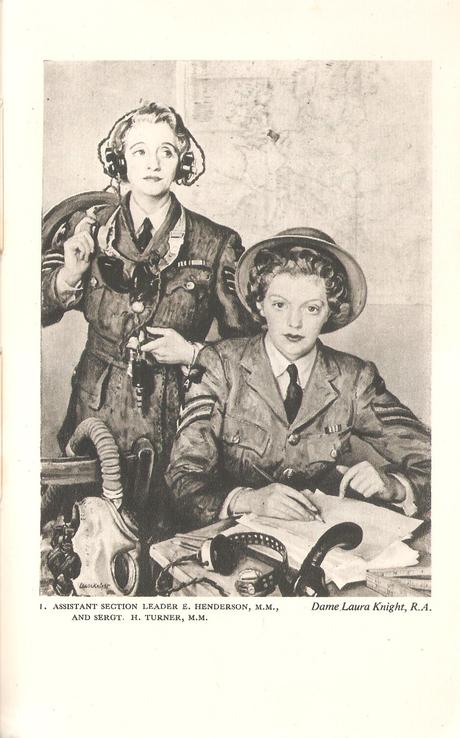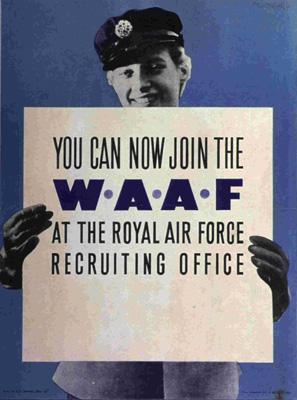Book Review by Chris Hopkins.
I was very pleased to discover this Mills & Boon novel about five years ago when I first started to explore fiction about British Servicewomen in the Second World War. I have just finished it for the second time and have to confess that I enjoyed it at both readings.

The heroine is called Miranda Lyle and the central WAAF theme is announced in the very first sentence of the novel:
When Miranda Lyle calmy announced at breakfast one morning her intention of joining the W.A.A.F.’s her father could scarcely have been more taken aback if she had just proposed swimming the Atlantic. Miranda in uniform, marching, drilling, saluting, scrubbing floors, peeling potatoes, doing all kinds of ‘fatigues’ – no, he simply couldn’t visualise it. She must be joking (p. 5 – all references are to the second edition, 1944).
Clearly, Mr Lyle does not have high expectations of the WAAF (Women’s Auxiliary Airforce), seeing service – or initial training anyway – as being entirely made up of repetitive drill and ‘low -level’ domestic tasks. I suspect the novel’s opening is indeed picking up an actual parental anxiety of the time, though it was generally the case that expectations about the WAAF and the WRNS were higher than for the ATS which among some of the public had an initially lower reputation.
It also quickly becomes clear that Mr Lyle’s worries are also telling us something about his and Miranda’s class-position and personal histories, and about his sense of her character. He is the owner of a London department store and very well-off. His wife has died soon after Miranda’s birth and she has been brought up wanting nothing, with the best nurses and governesses. However, she has lacked close family affection. Mr Lyle has been busy every day with his personally-run business, and is a somewhat remote figure in her childhood, only just getting to know her now she has reached adulthood (or just short of eighteen anyway – it was possible to volunteer for the Services at seventeen and a half). She has had a very sheltered life – she did not go to school and has never had any paid employment. My Lyle thinks Miranda is shy and fragile by nature, rather than because she has lacked opportunity to develop:
It wasn’t that he hadn’t the greatest admiration for the girls in the three Women’s Services. He knew they were doing a marvelous job, that without them the whole war effort would be hopelessly crippled. It wasn’t, either, that he thought Miranda too good for such a job or any snobbish nonsense like that. It was just that she was totally unsuitable. Not strong enough in the first place, and – why not be honest and admit it? – too spoilt and pampered (p.6).
Miranda admits to herself that much of her life has been passed in daydreams rather than in reality – she is an ‘avid reader’ and is often influenced by ‘romantic novels and films’ (p.9). Indeed, her sudden decision to join up is in general motivated by an urge to contribute to the war effort rather than sitting idly by, but also has a specific spark from a newspaper which she is perfectly aware has a strong element of fantasy as far as she is concerned:
On one page was an advertisement for recruits for the W.A.A.F.; opposite it was the smiling portrait of a member of that Force who had been decorated by the King for gallantry under fire. She had, it appeared, remained at her telephone, giving and receiving urgent messages with complete disregard for her own danger, though the building was ablaze as a result of an enemy raid (p.8).
This refers to a famous event of September 1940, when two WAAFs serving on an RAF fighter base were both awarded the Military Medal for remaining at their communications post and passing on key messages while being bombed and after the building caught fire. They were Sergeants E. Henderson and H. Turner, who featured in a joint portrait by Dame Laura Knight. The painting was commissioned and exhibited by the Ministry of Information under its War Artists’ Advisory Commission scheme, and was reproduced in black and white as the first painting in Knight’s book War Pictures by British Artists: Women (Oxford University Press, 1943). Readers are likely to have recalled the incident and its impact on pride in the WAAF.

Soon Miranda has slipped easily into a daydream about her own medal (she later reflects that what most WAAFS contribute is endurance rather than bravery). Nevertheless, she does what she has said she will do and goes to the RAF Recruiting Office in Kingsway (she naturally takes a taxi). Joining up seems momentous to her, but is clearly more routine for the recruitment office personnel.

The WAAFs first birthday | RAF Museum
Soon she is on a train with her fellow-joiners to their basic training camp. Miranda finds this fundamental part of the process much more difficult than she expects – while everyone else introduces themselves, she is rendered speechless by shyness. The obvious question asked to get a conversation going and to get to know each other is an immediate embarrassment to her: ‘What did you do in Civvy Street?’. Her answer that she did nothing but live with her father might not have been too bad, but she makes things worse by offering everyone a cigarette from her gold cigarette-case, leading one of the women to say, ‘Thanks Duchess’, a name which instantly sticks. The WAAF who coins the nick-name is Rita Leffield, an ex-chorus girl from a poorer background, who likes to make people laugh and has no objection to doing it as Miranda’s expense. However, another WAAF, Peggy, befriends Miranda and helps her through some initial social difficulties (including tactfully suggesting that using five-pound notes, a parting gift from her father, to pay for her tea in in the NAAFI may attract attention. Peggy is from a more ordinary background – she had been a florist, her father is a London bus driver, and her mother now an Air-Raid Warden, and she has five siblings. Peggy calls Miranda Mandy and soon this becomes her name, even when she returns home on leave, and in effect gives her a kind of rebirth.
In the shapes of Rita and Peggy, who are both posted to the same bomber airfield as Mandy, and the community of WAAFs there , the novel introduces one of its major themes – the benefits of class-mixing, and the people’s war idea that class-origins are irrelevant to contribution to the war-effort. In Mandy’s case we see that this does her nothing but good – she and Rita even come to a better understanding eventually after Rita saves her from a building hit by a bomb.
So far, I have of course failed really to identify anything particularly Mills & Boon about the novel, and have not even mentioned the love interest and the male lead. Well, that topic and that actor are certainly there, but equally there is much in the novel, especially early on, which resembles the narratives of other fictional and semi-documentary women’s joining-up texts. Soon an exceedingly handsome RAF officer is introduced to Mandy, who is a Squadron Leader, a holder of the DFC, and a Polish Count. She has such trouble with his surname that they both agree she will call him simply Count Alexei. Needless to say, Rita is quickly making jokes about Mandy soon being a Countess. Alexei does indeed have something of a reputation and a number of fellow WAAFs, some with longer service on the Bomber base, warn Mandy to be cautious of him. In fact, he treats her with perfect respect because he is completely smitten, but this leads to a painful misunderstanding on her part that he is uninterested in her at all. The emotional plot which in many ways drives the novel draws on various misprisions between Alexei and Mandy – for example, she misreads his concern for a fellow bomber pilot’s widow and child – though there are other obstacles too, including her father’s insistence that they must wait to marry till the end of the war, and his concerns about how she will fit into post-war life in Poland. Naturally, this love plot takes place in the very real and heightened context of the Squadron Leader’s bombing-missions over Europe and her almost nightly anxiety that he will fail to return.
It is then a proper Mills & Boon (though the formulas seem in some ways to have been less strictly formulated at this period). However, there were some features which surprised me a little. Firstly, there is an unexpected strand of metafictional self-consciousness, as in this narratorial/authorial address to the reader:
Now in case anyone reading this may have got the idea that being in the WAAFS seems to be just one jolly long picnic we’d like to correct that totally false impression … Mandy worked as hard as the rest of the girls in her section, which was jolly hard indeed.
No one – not even in war-time can work the whole twenty-four hours … and from now on you’ll understand if we take Mandy’s hard work more or less for granted. Every once in a while we may have occasion to refer to it, but somehow we think you’ll be keener to know if she eventually marries Alexei than if she gets her sergeant’s stripes or is recommended for a commission.
In peace-time what would you think of your library book if Chapter One began: ‘Janet’s typewriter was in a shocking state. The keyboard was stiff, the capital “D” was clogged with ink, the semi-colon was missing …’.
‘Nuts to that’, you’d probably say, flinging the book aside, and who could blame you? (pp.104-6).
In some ways this might seem frivolous in wartime, but there is in another way a tough-minded appreciation of the reader’s imagined situation and motivations for reading a Mills & Boon or other novel in that context, besides which in fact there is a sustained sense of how the timetable of on and off duty hours shapes both WAAF and RAF lives, and indeed Mandy and Alexei’s relationship.
At another point, when Mandy and another WAAF are in hospital having suffered blast injuries and minor burns during a bombing raid on the aerodrome, there is some amusing reference to Mills & Boon style romances. Ken Tindle, a wounded soldier returned from a POW camp, who is also interested in Mandy, visits her in the hospital bringing two new novels, and explain they are both ‘light’, one by ‘Barbara Stanton, one by Carol Gaye’ (p.130). Carol Gaye in fact wrote many novels during this period for Collins romance list – one which was very much a rival to Mills & Boon’s list (see Joseph McAleer, Passion’s Fortune: the Story of Mills & Boon, Oxford University Press, 1999, p.74). A specific novel title is named in this scene, Stanton’s The Perfect Husband (1942), which Mandy lends to Ellerton, the other wounded WAAF, who is grateful because her uncle who is ‘a bit of a highbrow’ has sent her War and Peace to accompany her through her convalescence, and she is so far finding it ‘heavy going’.
In the sense that Alexie and Mandy do marry, all the problems are worked out satisfactorily, though till the end with nicely- sustained possibilities for the reader that in one way or another the story will not end happily. The novel is though very clear that a happy-ever after ending is very provisional in this context – the war may last for some years more and Alexei will have to keep flying missions. This is made clear in a final self-conscious turn to the reader:
Now if any sourpusses or cynics have got as far as this (which doesn’t somehow seem likely) we can imagine the expressions on their disgusted faces as they mutter …
‘That hectic kind of love is no proper basis for a lasting marriage’.
‘Alexei’ll be lucky, anyway, if he comes through the war alive’.
‘If he does get back to Poland, he’s practically certain to find his money all gone and his castle all in ruins’.
…
Life and love are full of risks, in peace-time almost as much as in war. To run away from them is no recipe for happiness. Where did that deadly slogan ‘Safety First’ ever get anyone – nation or individual? (p.207)
Joseph McAleer says that Mills& Boon authors, novels and heroines added ‘a strong dose of patriotism and social commentary’ to their repertoire during the Second World War (p.171) and that they contributed to civilian morale (and perhaps military too, if Aircraftwoman Ellerton is an example?). W.A.A.F into Wife certainly has elements of both patriotism and social commentary. I was hoping there would also be Mills & Boon ATS and WRNS novels to compare it to – but as far as I can see there were none, and Stanton’s novel appears to be the unique Mills & Book servicewoman novel. However, I have recently found Aircraftwoman Grey by Juliet Rhys-Williams (Rich & Cowan, 1943) and it looks as if it may be a second WAAF romance. I will report back in due course.
